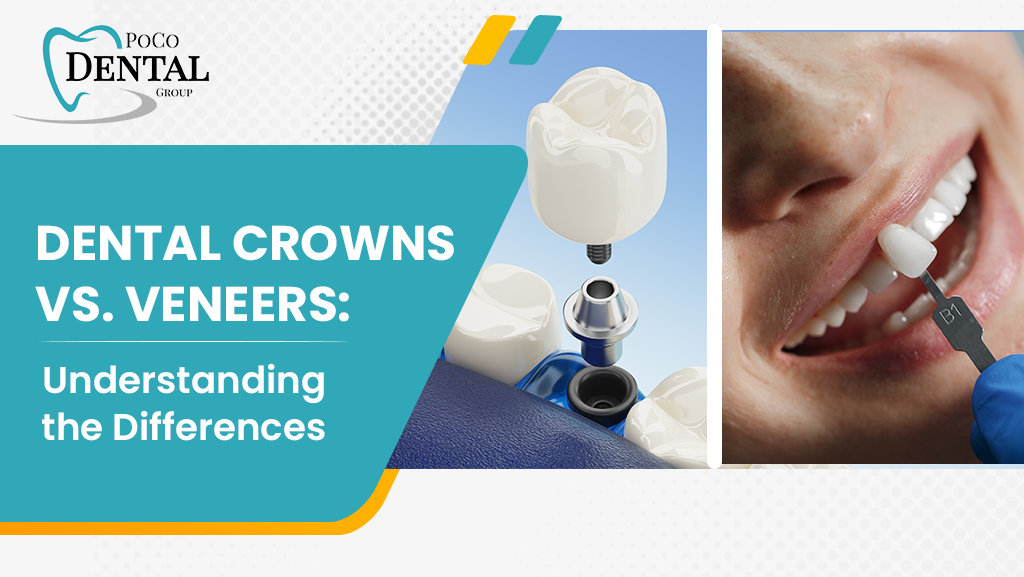A dazzling smile can boost confidence and leave a lasting impression, but achieving that perfect smile often involves dental procedures. Two common solutions for enhancing the appearance of teeth are dental crowns and veneers. While both serve cosmetic purposes, they differ significantly in their applications, procedures, and outcomes. In this comprehensive guide, we’ll delve into the differences between dental crowns and veneers to help you decide which option is best suited for your needs.
Understanding Dental Crowns
What Are Dental Crowns?
Dental crowns, also known as caps, are tooth-shaped prosthetics covering a tooth’s entire visible portion. They are commonly used to restore the shape, size, strength, and appearance of a tooth that has been damaged, decayed, or undergone a root canal treatment. Crowns can be made from various materials, including porcelain, ceramic, metal alloys, and a combination of these materials.
When Are Dental Crowns Recommended?
Dentists typically recommend dental crowns in the following situations:
- To Restore Damaged Teeth: Crowns restore teeth with significant decay, cracks, or fractures.
- After a Root Canal: Following a root canal procedure, a dental crown is often placed to protect the treated tooth and restore its functionality.
- For Cosmetic Enhancements: Crowns can improve the appearance of misshapen or discoloured teeth.
The Dental Crown Procedure
The process of getting a dental crown involves multiple steps:
- Consultation and Examination: The dentist assesses the tooth’s condition, discusses treatment options, and determines whether a dental crown is suitable.
- Tooth Preparation: The tooth receiving the crown is prepared by removing a portion of its outer structure to make room for the crown.
- Impressions: Impressions of the prepared tooth are taken to create a customized crown that fits perfectly.
- Temporary Crown: While the permanent crown is being fabricated, a temporary crown may be placed to protect the tooth.
- Permanent Crown Placement: Once the permanent crown is ready, it is securely bonded to the prepared tooth using dental cement.
Exploring Dental Veneers
What Are Dental Veneers?
Dental veneers are thin shells, usually made of porcelain or composite resin, that are custom-made to fit over the front surface of a tooth. Unlike crowns, veneers do not cover the entire tooth; instead, they focus on enhancing the appearance of the front part, addressing issues such as discoloration, minor misalignments, or chips.
When Are Dental Veneers Recommended?
Dental veneers are commonly recommended for the following purposes:
- Cosmetic Improvements: Veneers are an excellent option for enhancing the aesthetics of teeth with stains, discoloration, or minor imperfections.
- Correction of Minor Misalignments: Veneers can improve the appearance of slightly misaligned or uneven teeth.
- Closing Gaps: Veneers can effectively close small gaps between teeth.
The Dental Veneer Procedure
The process of getting dental veneers generally involves the following steps:
- Consultation and Planning: During the initial consultation, the dentist discusses the patient’s goals and evaluates whether veneers are a suitable solution.
- Tooth Preparation: A small amount of enamel is typically removed from the front surface of the teeth receiving veneers to ensure a proper fit.
- Impressions: Similar to the dental crown procedure, impressions are taken to create customized veneers.
- Temporary Veneers (if needed): Temporary veneers may be placed while the permanent ones are fabricated.
- Permanent Veneer Placement: The final veneers are bonded to the teeth using a strong adhesive, providing a natural and aesthetically pleasing result.
Key Differences Between Dental Crowns and Veneers
Now that we’ve explored the basics of both dental crowns and veneers let’s delve into the key differences between these two cosmetic dentistry options:
- Coverage Area:
- Crowns: Cover the entire visible portion of the tooth.
- Veneers: Cover only the front surface of the tooth.
2. Thickness:
- Crowns: Thicker than veneers due to their whole coverage nature.
- Veneers: Thin shells that require minimal enamel removal.
3. Purpose:
- Crowns: Primarily used for structural restoration and to protect damaged teeth.
- Veneers: Used mainly for cosmetic enhancements, addressing issues like discoloration and minor imperfections.
4. Tooth Preparation:
- Crowns: More extensive tooth preparation involves removing a significant portion of the tooth’s outer structure.
- Veneers: Minimal enamel removal, preserving more of the natural tooth structure.
5. Applications:
- Crowns: Suitable for teeth with substantial damage, decay, or after a root canal.
- Veneers: Ideal for improving the aesthetics of healthy or mildly flawed teeth.
6. Strength and Durability:
- Crowns are generally stronger and more durable, providing full coverage and support to weakened teeth.
- Veneers: While durable, they may not be as robust as crowns, as they focus on cosmetic rather than structural purposes.
Choosing Between Dental Crowns and Veneers
The decision between dental crowns and veneers depends on various factors, including the specific dental issues you want to address, the health of your teeth, and your cosmetic goals. Here are some considerations to help you make an informed choice:
- Nature of the Issue:
- If your primary concern is structural damage or a tooth with a root canal, a dental crown may be the more suitable option.
- Veneers are often the preferred choice for cosmetic improvements, such as discoloration or minor imperfections.
2. Tooth Health:
- If your tooth is generally healthy and only requires cosmetic enhancements, veneers may be a less invasive option, preserving more of your natural tooth structure.
- For teeth with significant damage or decay, crowns may be necessary to restore strength and functionality.
3. Long-Term Goals:
- Consider your long-term oral health goals. Veneers may be the better choice if you prioritize preserving natural tooth structure and require only cosmetic improvements.
- A dental crown may be more appropriate if the goal is to strengthen a weakened tooth or provide comprehensive restoration.
Conclusion
In the realm of cosmetic dentistry, both dental crowns and veneers play crucial roles in enhancing smiles and restoring confidence. Understanding the differences between these two options is essential for making an informed decision about which treatment aligns with your specific needs and goals. Whether you opt for the comprehensive coverage of dental crowns or the cosmetic finesse of veneers, the result is a radiant smile that reflects health and beauty.
Remember to consult with your dentist to discuss your case, as they can provide personalized recommendations based on your oral health and aesthetic objectives. With the right choice, you’ll be on your way to achieving the smile you’ve always dreamed of.
If you are searching for a dental clinic in Port Coquitlam, look no further than PoCo Dental Group. Book a consultation with us, and get a guide on which option is suitable for your oral health.




